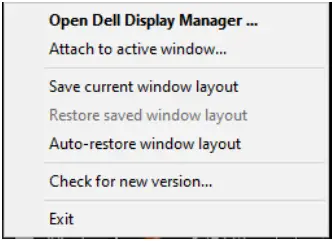DELL S2422HZ/S2722DZ Video Conferencing Monitor User Guide
NOTE: A NOTE indicates important information that helps you make better use of your computer.
Copyright © 2021 Dell Inc. or its subsidiaries. All rights reserved. Dell, EMC, and other trademarks are trademarks of Dell Inc. or its subsidiaries. Other trademarks may be trademarks of their respective owners. 2021 08 Rev. A00
Overview
Dell Display Manager is a Microsoft Windows application used to manage a monitor or a group of monitors. enables you to manually adjust the displayed image, assign automatic settings, energy management, window organization, image rotation, and other features on selected Dell monitors. After installation, Dell Display Manager runs each time when the computer starts and places its icon in the notification tray. For more information about monitors connected to the computer, move the pointer over the notification-tray icon.
Using the Quick Settings dialog box
Click the Dell Display Manager’s notification tray icon. The Quick Settings dialog box is displayed. When more than one supported Dell monitor is connected to the computer, a specific target monitor can be selected using the menu. The Quick Settings dialog box enables you to easily adjust the brightness, contrast, resolution, window layout, and so on. It also enables you to switch between preset modes automatically or to select a preset mode manually.
The Quick Settings dialog box also provides access to Dell Display Manager’s advanced user interface (UI) that is used to adjust basic functions, configure auto mode, and access other features.
Setting basic display functions
You can select Manual Mode that enables you to manually select a preset mode or select Auto Mode that applies a preset mode based on the active application. An onscreen message displays the current preset mode whenever it changes. The selected display’s Brightness and Contrast can also be directly adjusted from the Basic tab.

Assigning Preset Modes to applications
The Auto Mode tab enables you to select a specific Preset Mode with a specific application, and apply it automatically. When Auto Mode is enabled, Dell Display Manager automatically switches to the corresponding Preset Mode whenever the selected application is activated. The Preset Mode assigned to a particular application may be the same on each connected monitor, or it can vary from one monitor to another.
Dell Display Manager is pre-configured for many popular applications. To add a new application to the Application list, drag the application from the desktop, Windows Start Menu, or elsewhere, and drop it onto the current list.
NOTE: Preset Mode assignments for batch files, scripts, loaders, and nonexecutable files such as zip archives or packed files, are not supported. You can also configure the game preset mode to be used whenever a Direct3D application runs in full-screen mode. To prevent an application from using mode, assign a different preset mode to it.

Organizing Windows with Easy Arrange
Easy Arrange helps you to effectively organize your application windows on the desktop. Choose a pre-defined layout pattern, which suits your work, then drag the application windows into the defined zones. Press > or use Page Up or Page Down key to find more layouts. To create a custom layout, arrange the open windows, and then click Save.
For Windows 10, you can apply different window layouts for each of the virtual desktops.
If you often use Windows snap feature, select Hold down the SHIFT key to enable zone positioning. This feature gives Windows snap priority over Easy Arrange. You can hold down the Shift key to use Easy Arrange positioning.

If you are using multiple similar monitors in an array or matrix, Easy Arrange layout can be applied across to all the monitors as one desktop. Select Span multiple monitors to enable this feature. You must align your monitors properly to make it effective.

![]() NOTE: An application may require a minimum effective resolution for its application window. Such application may not fit in an Easy Arrange zone if the zone is smaller than the required window size.
NOTE: An application may require a minimum effective resolution for its application window. Such application may not fit in an Easy Arrange zone if the zone is smaller than the required window size.
Managing multiple video inputs
The Input Manager tab provides convenient ways to manage multiple video inputs connected to your Dell monitor. It enables you to easily switch between inputs while you are working with multiple computers.
All video input ports available on your monitor are listed. Name each input as per your requirement and save changes after editing. You can define a shortcut key to quickly switch to your favorite input and another shortcut key to quickly switch between two inputs if you often work between them.
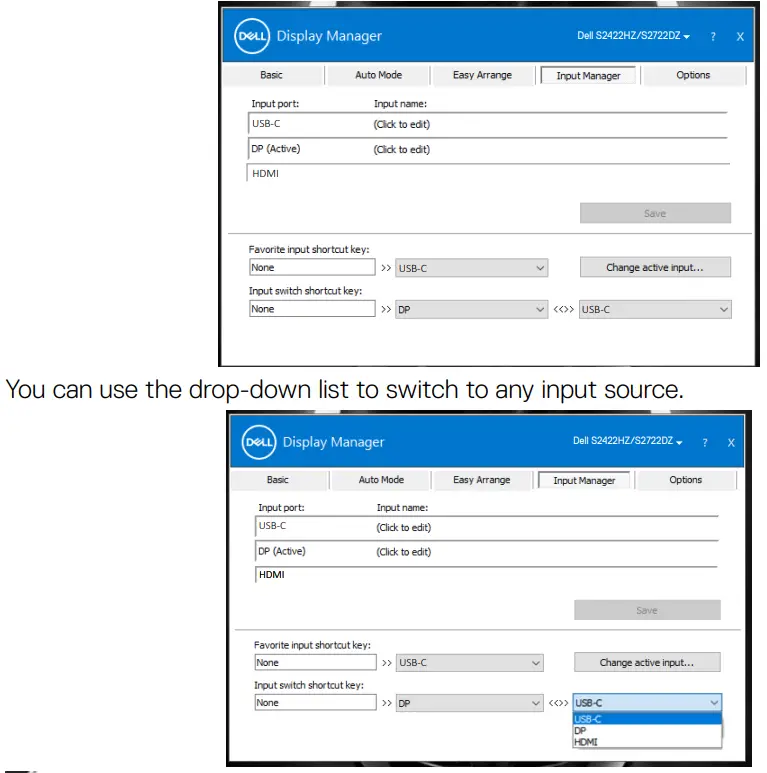

![]()
![]()
![]()
![]()
![]()
Restoring application positions
DDM can help you restore application windows into their positions when you reconnect your computer to the monitor(s). Right-click the DDM icon on the notification tray to quickly access this feature.
![]()
![]()
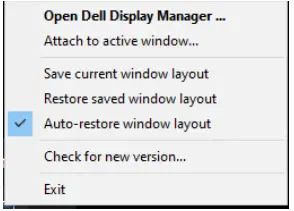

To go back to a favorite layout, select Save current window layout, and then Restore saved window layout.


You can use monitors with different models or resolutions in your daily routine, and you can apply different window layouts on them. DDM recognizes the monitor you have reconnected and restores the application positions accordingly. If you want to replace a monitor in a monitor matrix configuration, you can save the window layout before replacement and restore the layout after a new display is installed.
![]()
![]()
![]()
![]()
![]()
Applying energy conservation features
The Options tab on supported Dell models provide PowerNap energy conservation options. You can set the brightness to the minimum level, or put the display to sleep when the screensaver is activated.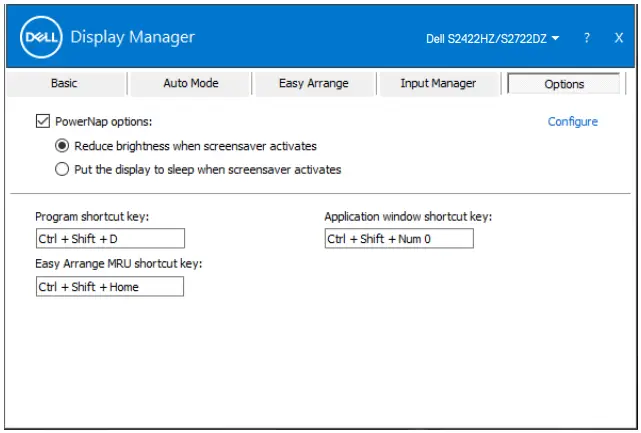

Defining shortcut keys
You can define the shortcut keys for quick access to the following DDM functions:
- Program shortcut key: To quickly open the Quick Settings dialog box.
- Easy Arrange MRU shortcut key: To quickly apply six recently used window layouts.
- Application window shortcut key: To launch a quick menu for options under Auto Mode and Easy Arrange.

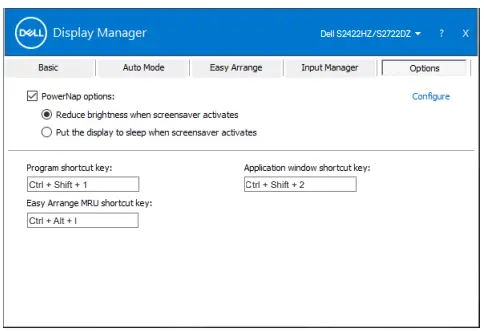
Attach DDM to active window (Windows 10 only)
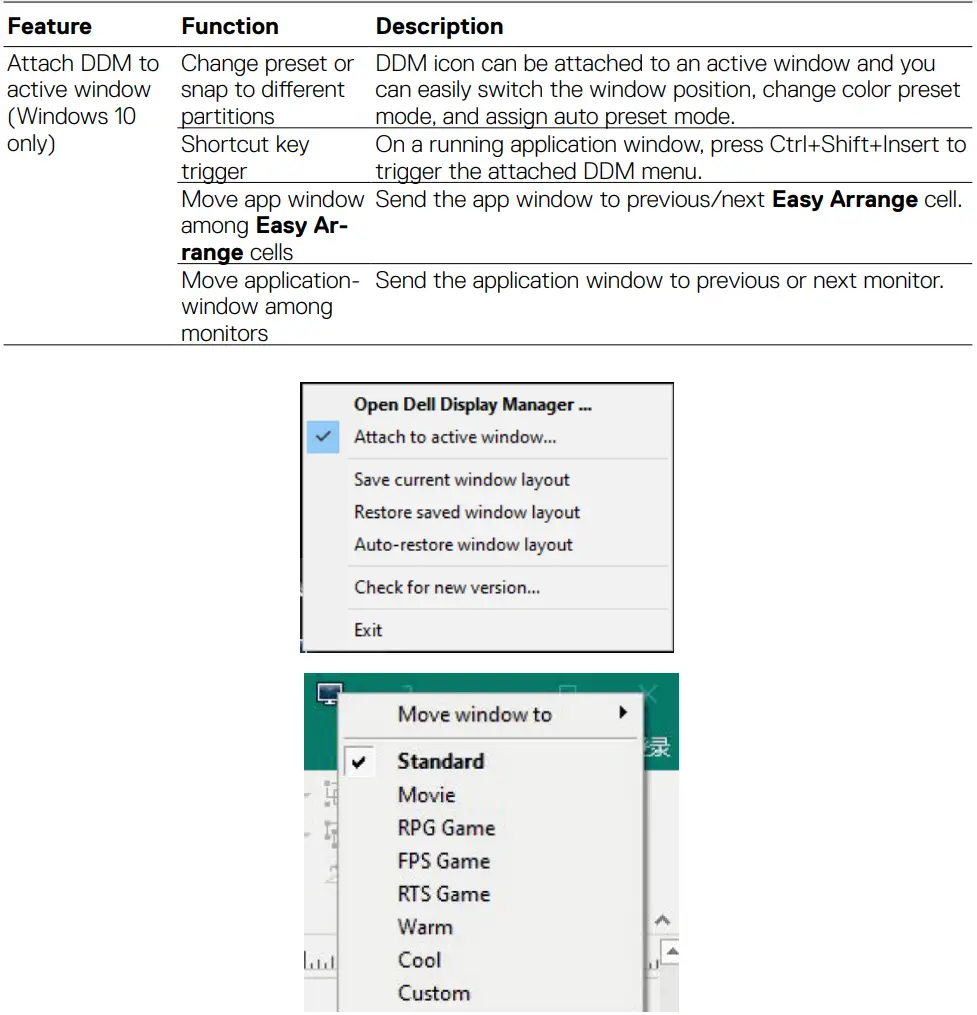

Troubleshooting
If DDM does not work with your monitor, the following icon is displayed in the notification tray.

![]()
![]()
![]()
![]()
![]()
- Ensure that the video cable is properly connected to your monitor and your computer. The connectors must be firmly inserted into position.
- Check the monitor OSD to ensure DDC/CI is enabled.
- Ensure that you have the correct and latest Graphics driver from the graphicsvendor (Intel, AMD, NVidia, and so on). Graphics driver is often the cause of DDM failure.
- Remove any docking stations, cable extenders, or converters between the monitor and the graphics port. Some low-cost extenders, hubs, or converters may not support DDC/CI properly and can fail DDM. Update the driver to the latest version available.
- Restart your computer.
DDM might not work with the following monitors:
- Dell monitor models earlier than year 2013 and D-series of Dell monitors. For more information, see https://www.dell.com/support/monitors.
- Gaming monitors using Nvidia-based G-sync technology.
- Virtual and wireless monitors do not support DDC/CI.
- Some early models of DP 1.2 monitors. It may be necessary to disable MST/DP 1.2 using the display OSD.
If your computer is connected to the Internet, you are prompted to upgrade to a newer version of DDM when it is available. It is recommended to download and install the latest DDM application. Right-click the DDM icon to check the latest DDM version.![]()
![]()
References
[xyz-ips snippet=”download-snippet”]

